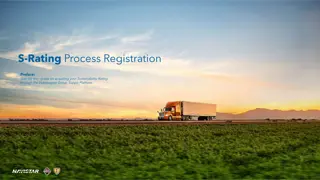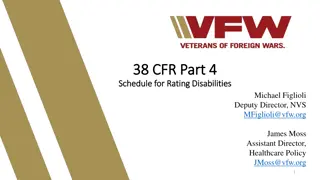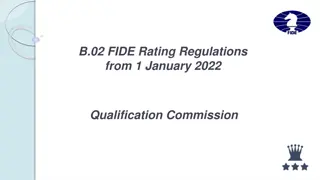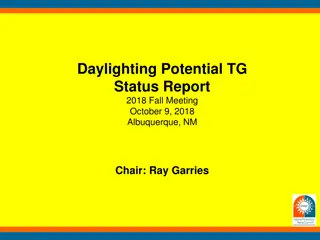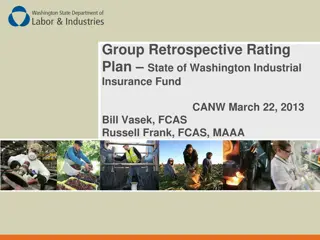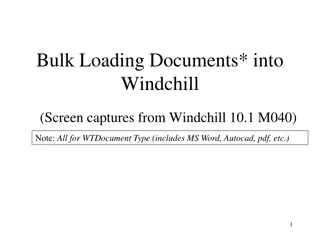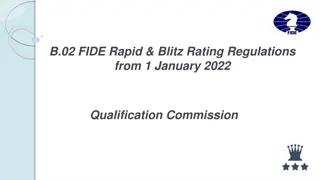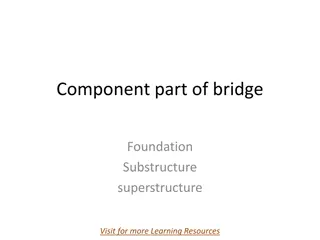Understanding Bridge Loading and Rating
Bridges are subjected to various types of loads such as dead load, live load, and other loads like wind and temperature effects. Dead load consists of the bridge's self-weight, while live load includes temporary moving loads. Bridges are rated to determine their load carrying capacity, especially in consideration of modern truck configurations. Various truck types and legal weight configurations for travel on roads are also discussed in the context of bridge loading and rating.
Download Presentation

Please find below an Image/Link to download the presentation.
The content on the website is provided AS IS for your information and personal use only. It may not be sold, licensed, or shared on other websites without obtaining consent from the author. Download presentation by click this link. If you encounter any issues during the download, it is possible that the publisher has removed the file from their server.
E N D
Presentation Transcript
BRIDGE LOADING AND RATING 1 Classification: Protected A Classification: Protected A 1
LOADS 2 Classification: Protected A 2
Types of Loads Bridges are subjected to many different types of loads. There are three important types of bridge loads: Dead load Live load Other loads (wind, snow etc.) 3 Classification: Protected A
Dead Load Dead load consists of the self-weight of the bridge. The load is usually stationary and permanent. Typical dead loads are: Beams and girders Concrete deck Asphalt wearing surface Curbs Railing 4 Classification: Protected A
Live Load Live loads are usually temporary and are applied in a short duration of time. The loads are usually moving. Typical types of live loads are: Truck load Dynamic load allowance (impact) Pedestrian load Longitudinal live load 5 Classification: Protected A
Other Loads The bridge is subjected to other loads beside dead and live load. Other typical bridge loads are: Wind load Earth pressure Ice pressure Temperature effects Collision loads 6 Classification: Protected A
Rating Bridges Many older bridges were designed to carry smaller and lighter trucks. Are these older bridges capable of carrying today s heavier and longer legal truck configurations? Bridges are rated to determine the load carrying capacity of the bridge. Generally, only the superstructure is load rated. The ratings normally assume that the bridge is in good structural condition. 7 Classification: Protected A
Real Truck Configurations There are many truck configurations that can legally travel on Alberta roads. The truck configurations are grouped into three categories: Single unit trucks Tractor semi-trailers Truck trains Within each of the categories there are many different weights and axle configurations. 8 Classification: Protected A
Typical Legal Single Unit Trucks 22.5 tonnes 5.5 t 8.5 t 8.5 t 3.0 1.2 29.2 tonnes 6.1 t 6.1 t 8.5 t 8.5 t 1.0 5.0 1.2 9 Classification: Protected A
Typical Legal Tractor Semi-Trailer Units 39.5 tonnes 5.5 t 8.5 t 8.5 t 8.5 t 8.5 t 3.0 1.2 5.0 1.2 46.5 tonnes 5.5 t 8.5 t 8.5 t 8.0 t 8.0 t 8.0 t 3.0 1.2 5.5 1.8 1.8 50.4 tonnes 7.3 t 8.5 t 8.5 t 9.1 t 8.5 t 1.2 8.5 t 3.5 1.2 3.5 3.5 10 Classification: Protected A
Typical Legal Truck Trains 56.5 tonnes 5.5 t 8.5 t 8.5 t 8.5 t 8.5 t 8.5 t 8.5 t 3.0 1.2 5.0 1.2 5.0 1.2 60.5 tonnes 5.5 t 8.5 t 8.5 t 8.5 t 8.5 t 6.0 t 7.5 t 7.5 t 3.0 1.2 5.1 1.2 2.5 5.9 1.2 63.5 tonnes 5.5 t 8.5 t 8.5 t 8.0 t 8.0 t 8.0 t 8.5 t 8.5 t 3.0 1.2 5.5 1.5 1.5 5.5 1.2 11 Classification: Protected A
Rating Truck Models Each one of the trucks produces unique forces and stresses in the bridge. It is not practical to load rate the bridge for each one of the real truck configurations. A model truck is used to represent each one of the truck configuration categories. CS1 Rating Truck Model - Single unit trucks CS2 Rating Truck Model - Tractor semi-trailer CS3 Rating Truck Model - Truck trains 12 Classification: Protected A
Rating Truck Models CS1 Rating Truck Model 28 tonnes 7.0 t 21.0 t 4.0 CS2 Rating Truck Model 49 tonnes 7.0 t 21.0 t 21.0 t 4.0 6.0 CS3 Rating Truck Model 63.5 tonnes for Primary & Secondary Highways 63.5 tonnes for Local Roads (Bulletin 8, 2021) 6.1 t 18.8 t 18.8 t 18.8 t 4.0 6.0 6.0 13 Classification: Protected A
Load Rating a Bridge Step 1 calculate load carrying capacity of critical member Step 2 calculate Dead Load this member is required to carry Step 3 member capacity less Dead Load, etc. is Live Load that the member can carry 14 Classification: Protected A
Rating Equation R - D L (1 + ID) Rating Equation = LLCF Where: LLCF = Live Load Capacity Factor (fraction of rating truck the bridge can safely carry for the load effect considered) = Resistance, load effect the bridge can safely carry = Dead load effect of the bridge = Live load effect due to the rating truck model = Impact (dynamic) factor for live load R D L ID 15 Classification: Protected A
Rating Equation (cont d) Live Load Capacity Factor (LLCF) is calculated for each rating truck model. A LLCF of 1.0 or greater indicates that the bridge is capable of safely carrying the current legal load for the particular truck category. 16 Classification: Protected A
Legal Loads on Alberta Roadways Truck Type Provincial Highways Local Roads Single (CS1) 28 28 Semi (CS2) 49 49 Truck Train (CS3) 63.5 63.5 (2021/previously 54) Note: Loads are expressed in tonnes 17 Classification: Protected A
Bridge Load Evaluation Manual For further information refer to Alberta Transportation Bridge Load Evaluation Manual at: https://open.alberta.ca/publications/7027044 20 Classification: Protected A
Questions? 21 Classification: Protected A




